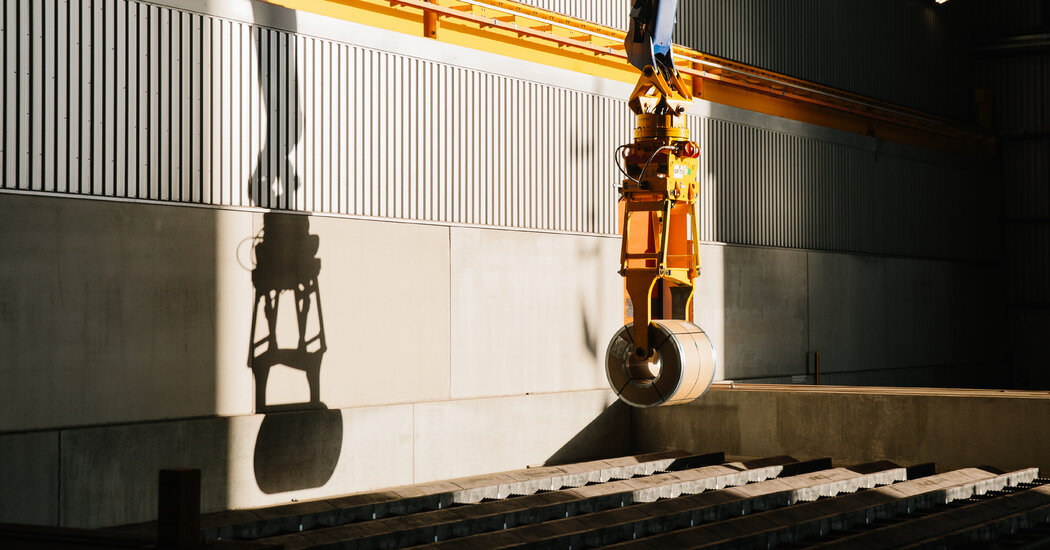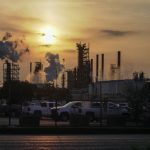
Few materials are more essential than steel, yet steel mills are among the leading polluters. They burn coke, a derivative of coal, and belch millions of tons of greenhouse gases. Roughly two tons of carbon dioxide rises into the atmosphere for every ton of steel made using blast furnaces.
With climate concerns growing, a crunch appears inevitable for these companies. Carbon taxes are rising, and investors are wary of putting their money into businesses that could be regulated out of existence.
None of this has been lost on the giant steel maker ArcelorMittal.
For half a century, Lakshmi Mittal devoted himself to building and running what became the world’s largest empire of huge steel mills, employing nearly 170,000 people.
Now his son, Aditya Mittal, 44, who recently succeeded his father as chief executive, says the industry that has made the family’s name and fortune needs to change its polluting ways.
“The largest challenge the world is going to face over the next 30 years is how we decarbonize,” he said.
The company is spending 325 million euros (about $390 million) on pilot programs that include making steel with hydrogen and using bacteria to turn carbon dioxide into useful chemicals. The amount is less than 1 percent of the company’s 2020 revenue. But Mr. Mittal, who had been ArcelorMittal’s chief financial officer, said the company had greater technical resources and global scale than most rivals and was well positioned to lead the cleanup.
“We can now imagine that it is possible to make steel without carbon emissions,” he said.
But the future costs of converting a string of blast furnaces into climate-friendly operations are likely to run into tens of billions in Europe alone, the company says.
In recent years, the oil and gas industry has come under pressure from governments embracing increasingly ambitious climate goals. One result is greatly expanded investments in renewable energy. Now, many see the regulatory focus turning to the steel industry and other heavy polluters.
Iron and steel are the source of an estimated 7 percent of global carbon dioxide emissions. While the metal will be needed for the foreseeable future in many products, including electric vehicles and wind turbines, the process of producing steel is now viewed as a potential red flag for investors and even customers.
The task is tall at ArcelorMittal.
“They have a lot of things to improve,” said Gerrit Ledderhof, a responsible-investment manager at Aegon, a Dutch investment manager. “Big facilities in Belgium, France, all over the place.”
Aegon is nudging ArcelorMittal to clean up on behalf of a group of large investors called Climate Action 100+, and its representatives are hopeful that Mr. Mittal may accelerate change.
“I think he has the openness,” Heike Cosse, who leads Aegon’s dialogue with ArcelorMittal, said of the new chief executive.
ArcelorMittal has plants all over the world, but the environmental pressures are particularly acute in Europe, where it makes about half its steel. The company’s headquarters are in Luxembourg, and Ursula von der Leyen, who became the European Commission president in 2019, is increasing efforts to tighten up on pollution.
It is expected that the penalties for emissions under Europe’s carbon trading program and other measures will rise rapidly in the coming years, cutting into steel makers’ already slim profits.
“Everyone expects the regulations to be imposed to be very strict,” said Akio Ito, a senior partner at the consultants Roland Berger in Munich.
Mr. Ito said that in a few years, the carbon tariff might increase to as much as €150 per ton of steel, around 20 percent of the current price of a ton of the metal. If so, it could become too costly to make steel in Europe, he said.
In 2019, ArcelorMittal’s global operations made 90 million metric tons of steel, about 5 percent of the world total, while producing 185 million metric tons of carbon dioxide emissions.
Mr. Mittal is moving cautiously, trying several approaches. The company’s flagship mill near Ghent in Belgium is central to this effort. In one of several experiments, workers are erecting large tanks where bacteria will feast on carbon dioxide from plant exhaust and turn it into ethanol, which can then be used in making chemicals. At another plant, in Hamburg, Germany, the staff has run laboratory tests using hydrogen, which is gaining favor as a clean fuel in place of coke. Mr. Mittal is also contemplating hooking up the company’s electric furnaces, which are cleaner than blast furnaces, to a source of renewable power to produce steel branded as low-carbon.
Executives indicate that using hydrogen may eventually be the best solution but is many years away. Hydrogen made without causing emissions is expensive and limited.
“Today, this is impossible, because there is no hydrogen,” said Geert Van Poelvoorde, chief executive of ArcelorMittal Europe.
ArcelorMittal says up to €40 billion of investment will be needed over the next three decades to remove the emissions from steel making in Europe alone, depending on the methods. The cost of producing steel will also rise sharply.
At least one European steel company, SSAB of Sweden, may be making progress. With government backing, the company plans to eliminate fossil fuels by using hydrogen made from electricity generated by water power. If all goes well, a large-scale plant could begin operating in around five years.
“In the beginning, it might cost some more, said Martin Pei, the company’s chief technology officer. He added that the company would gain a new product that it could sell for a premium.
ArcelorMittal is a giant in the industry, but even it cannot afford to throw money around. For 2020, when economies were shut down because of the pandemic, the company reported a $733 million net loss. It has been concerned about debt, and last year sold much of its business in the United States.
How to pay for reducing emissions is the subject of complex negotiations between the industry and governments, including the European Union. Governments may want to clean up steel, but they also will be wary of jeopardizing an industry that employs about 330,000 people in the region. In addition, if European steel moves elsewhere, the likely result would be higher emissions.
ArcelorMittal and other companies are applying for funding from European programs for their efforts to reduce carbon. The steel industry is also pressing for what it calls border adjustments, which would levy tariffs on steel imports from countries with fewer environmental regulations — an approach that risks trade friction and could leave European steel less competitive in export markets.
Without financial support from governments, Mr. Mittal said, “the incentive to produce steel in Europe would not exist.”
By 2030, Mr. Mittal wants to reduce carbon dioxide emissions in Europe by 30 percent compared with 2018; he hopes the whole company will be carbon-neutral by 2050. In the meantime, the company is trying to cater to growing customer demand for low-carbon steel by making modest investments, like using natural gas in place of coke at a plant and then selling an amount of steel equivalent to the carbon saved as “green steel.”
An early customer for this niche product, which differs from ordinary steel only in labeling, is Jean-Christophe Vigouroux, chief executive of Ateliers 3S, a supplier of custom roof material and facades in Clermont-Ferrand, France. In an interview, Mr. Vigouroux said he had ordered 1,000 tons of green steel at a roughly 10 percent premium over the market price.
“Clients increasingly appreciate the eco-design aspects of our products,” Mr. Vigouroux said.
Mr. van Poelvoorde said that being able to sell the material at a premium was a pleasant surprise that would help finance lower emissions. More important, he said, offering a product labeled green shows customers and the authorities, who are considering funding these efforts, “we are very serious, that it is not only talking.”

Average Rating